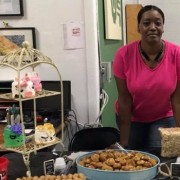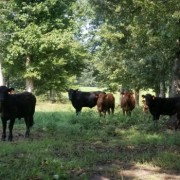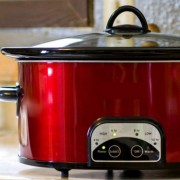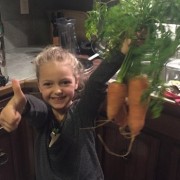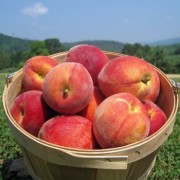From the Army to the farm, this veteran continues to serve
– By the Veggie Fairy Team
When Seasonal Roots’ Farmer Connector, Sam, recently visited Cattle Run Farm, LLC, he quickly observed happy, grassfed beef cows grazing the rolling pastures in central Virginia. You can count on Sam to find the best producers we can all feel good about. Cattle Run Farm, LLC, is a third generation family farm and veteran-owned, with the best grassfed beef.
After five deployments and 21 years in the Army, 1st Sergeant Ralph T. Morton retired in 2017, to his family farm in Ruckersville, Va., to help his father and sister with the 175-acre family farm. But his dad’s health was failing, and just two months later he passed away. Through his legacy and commitment to educating the future, Ralph is excited about continuing the family’s farming tradition with innovation and strategic initiatives. Not only does the farm provide grassfed beef, but they produce thornless blackberries, herbs, and vegetables.

In between his daily farm chores, this veteran continues to serve others as he welcomes school groups, 4-H groups, community members, and other veterans to the farm, to engage in non-formal learning opportunities.
Ralph, a 4-H alum himself, and Cattle Run Farm, LLC, are designing an Agricultural Innovation Learning Lab (AILL) to innovate, motivate, and educate youth and families about science, technology, engineering, agriculture, and math (STEAM) using agriculture. The primary focus of the AILL is to provide hands-on, real-life application experiential learning opportunities that support social-emotional learning and community development. Additionally, programs are designed to develop curiosity and stimulate critical thinking, problem-solving, and analytical skills, while linking key concepts to prior knowledge and practice.
The program will run from July 8, 2019, to August 1, 2019. Start your planning early as they only have 60 slots available. We will keep you posted about the registration process!

Obviously, Ralph is committed to teaching the next generation, and the Veggie Fairy wanted to find out why.
VEGGIE FAIRY:
Why teach children who aren’t growing up on farms about good farming practices?
RALPH:
If we don’t preserve the family farm way of life, we’ll be a dying breed. All our food will come from big corporations, who don’t have the same commitment to good animal husbandry and land stewardship as small farmers do. Therefore, we wonder why we have unhealthy communities. Good agrarian practices lead to good health.
VEGGIE FAIRY:
How did you learn about farming?
RALPH:
Farming has been a part of me since I was a little boy. I have been around farming my whole life. I was born and raised here on the farm. I grew up learning from my father and grandfather, and participating in 4-H youth development activities.
My vision is to do the same thing with my children that my father and grandfather did with me. I have four kids — the oldest is in college at the University of Arizona, while the younger three enjoy being out on the farm. As a parent, it’s important to expose and engage children at an early age to help them develop skills, a work ethic, and to have a greater appreciation for agriculture and natural resources.

I give our kids animals to be responsible for and they look forward to coming out every day to feed and care for them. Kids are sponges. You show them something one time and they’re saying, “I want do it! I want to do it!”

VEGGIE FAIRY:
Why did you choose to stick with grassfed?
RALPH:
For us, it makes raising cattle economically feasible. We have a lot of grass and living outside on pasture is low stress for them. Grassfed means cattle are allowed to forage and graze for their own fresh food. I use a rotational grazing system, using best practices gleaned from USDA Natural Resources Conservation Service (NRCS). We took our pastureland and divided it into ten paddocks. Every seven days the cows rotate to a new paddock of fresh grass. This allows the grass to grow back for the next rotation. We do supplement the grass with a little bit of non-GMO grain, that is purchased from our local co-op. Maintaining good animal health requires giving them proper grasses, forages, and legumes which requires good soil health.
VEGGIE FAIRY:
How do you keep the soil healthy?
RALPH:
Soil management is a key part of rotational grazing. We use both commercial and organic fertilizers. We are constantly monitoring the health of the soil by taking soil samples twice a year and adding the proper nutrients as needed. We plant legumes such as different types of clovers that naturally release nutrients into the soil through their roots.
Clover is a legume crop, belonging to the bean and pea family of plants. Legumes perform a unique service among the plant world. They fix nitrogen in the soil, transforming nitrogen gas found in air pockets of soil into organic compounds that can be used by plants. They do this by partnering with beneficial bacteria in the soil called Rhizobia, which grows in rounded nodules along the plant’s roots. Once legumes fix nitrogen, surrounding plants can use the nitrogen compounds to fuel growth.
If you just take, take, take from the land and don’t put back, the animals and the grasses won’t get the nutrients they need to grow and produce.

VEGGIE FAIRY:
We see you caring for your cows in the snow. How much do your cows stay outside in their natural environment?
RALPH:
Our cattle stay outside the entire time. Every once in a while, one might get a runny nose which can lead to transmittable respiratory problems – that’s the only time we administer antibiotics. Confinement, once you start confining them into feed lots, they get crowded and hot and it turns into a muddy muck hole. Not to mention a high-stress environment, which causes sickness and impacts the quality of the beef. Cattle turned out on pastures stay healthier and less stressed.
Another health practice for our herd is we fenced off our streams, as cattle like to stand in the water when it’s hot to stay cool. But then they develop foot problems and the streams become polluted, which is not environmentally friendly. So we have natural tree canopies for shade and put in an automatic watering system to ensure they’re consuming fresh water daily.
(VEGGIE FAIRY NOTE: Animals on farms that never give antibiotics may suffer unnecessarily if they do get sick and can’t be properly treated. The opposite problem occurs in conventional feed lots that crowd animals together in an unhealthy environment – often, all the animals have to be given antibiotics all the time just to prevent them from getting sick. As a result, some bacteria have become resistant to antibiotics, which is making it harder to fight bacterial infections in humans, too.)
VEGGIE FAIRY:
How many cattle to you have at one time?
RALPH:
We run a cow-calf operation, a grow-your-own concept, so we’re not just buying someone else’s calves and fattening them up. We run anywhere from 40-45 head. We “background” all our calves, meaning when they’re ready we wean them off their mothers and condition them for 45 days. This prepares them to be turned out to pasture for grazing. Calves on a good forage program can gain anywhere from two to three pounds per day, which is good basic animal husbandry. The management is very methodical.
VEGGIE FAIRY:
How does that compare with feed lot farming?
RALPH:
Finishing cattle is a very methodical process. It takes a great deal of planning and crunching numbers. The farmers who are in the cattle feeding business, operating a feed lot, don’t have much time to get their cattle to a certain weight to meet the packer’s request. They only have a window of anywhere from 120 to 240 days to get a 500- to 700-pound steer to a market weight of 1200 to 1300 pounds. Growth implants are delivered through a pellet under the skin in the animal’s ear. They enhance the reproductive hormones that occur naturally in the animal. In steers implants replace some of the hormones that were removed when the animal was castrated. Implants generally encourage protein deposition and discourage fat deposition. This improves both weight gain and feeds conversion. Fat deposition requires more than twice as much feed energy as protein deposition does. At Cattle Run Farm, we don’t foster these practices.
*
So those are just some of the facts that back up what we always say here at Seasonal Roots: Humane farming is good for the animals, good for us, and good for the planet!
Read about another grassfed farm that’s also part of the Seasonal Roots family.
Here are tips for cooking grassfed beef, which is different from grainfed because it has less saturated fat, more heart-healthy omega-3 fatty acids, and more antioxidants like vitamin E.
ABOUT SEASONAL ROOTS
Since 2011, Seasonal Roots’ online farmers market has connected Virginia families with local family farmers who use sustainable, humane practices. Our veggie fairies – mostly moms who believe in living better through scrumptious, healthy eating, being kind to animals, protecting the environment, and spreading joy – home-deliver freshly harvested produce, pastured eggs, grassfed dairy and meat, plus artisan fare. We empower our members to eat better and live better with more nutritious, flavorful food that’s good for us and good for the planet. More info at seasonalroots.com.
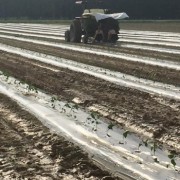
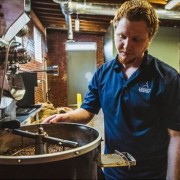








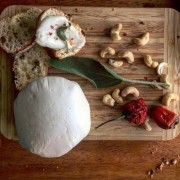








 – By Morgan P, veggie fairy & neighborhood Market Manager in Virginia Beach
– By Morgan P, veggie fairy & neighborhood Market Manager in Virginia Beach